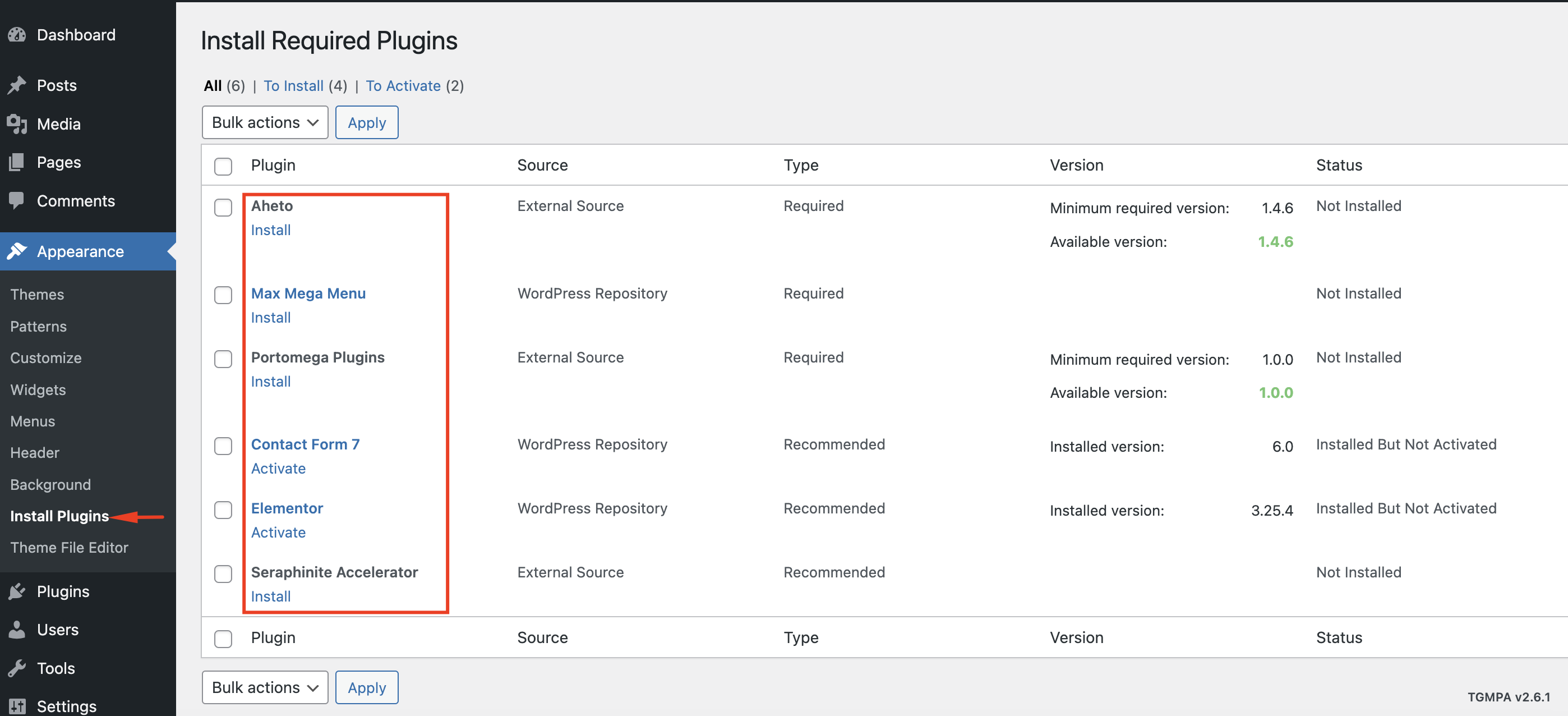Introduction #
The Portomega theme requires specific plugins to function optimally, and additional recommended plugins are available to enhance performance and customization options. This guide will cover the purpose and functionality of each plugin and how to install them all together through the Appearance > Install Plugins section in WordPress.
Required Plugins for Portomega Theme #
The following plugins are essential for the Portomega theme and must be installed for core functionalities to work.
1. Aheto #
- Purpose: Aheto manages templates, demo content, and provides access to a variety of page-building elements specifically designed for Portomega by FOX-THEMES.
- Features:
- One-click demo import to quickly set up the website.
- Pre-made templates and layouts to jumpstart design.
- Integration with page builders like Elementor for seamless customization.
2. Max Mega Menu #
- Purpose: This plugin adds advanced menu functionality, allowing you to create customizable, multi-level navigation menus that improve user experience and enhance site navigation. See documentation via official site here.
- Features:
- Drag-and-drop interface for menu design.
- Advanced menu options like icons, widgets, and responsive styling.
- Perfect for building complex menu structures, which integrate well with Portomega’s header layouts.
3. Portomega Plugin #
- Purpose: The Portomega Plugin adds theme-specific widgets and elements that are unique to the Portomega design. These widgets allow for additional content styling that aligns with the theme’s aesthetics.
- Features:
- Includes custom widgets tailored to the Portomega style.
- Allows for more cohesive design and theme-specific content blocks.
- Easily accessible in the WordPress widget area for drag-and-drop placement.
Recommended Plugins for Portomega Theme #
These plugins are not required but are recommended to improve site functionality, customization options, and performance.
1. Contact Form 7 #
- Purpose: Contact Form 7 provides a simple way to add customizable forms to your website. It’s ideal for creating contact forms or gathering visitor information.
- Features:
- Easily customizable forms.
- Supports reCAPTCHA, file uploads, and AJAX-powered submissions.
- Integration with Portomega’s styles for consistent design.
2. Elementor #
- Purpose: Elementor is a visual page builder that allows you to create complex page layouts without any coding knowledge. It’s highly compatible with Portomega, making it easier to design pages that align with your theme’s design.
- Features:
- Menu themes for page building interface.
- Menu Locations adjustments.
- Custom CSS styling additions that integrate smoothly with Portomega.
3. Seraphinite Accelerator #
- Purpose: This plugin improves the speed and performance of your site, optimizing load times and ensuring a smoother experience for visitors.
- Features:
- Separated, Images, Styles and script optimization to improve load speed.
- Built-in caching for enhanced performance.
- Compatible with WordPress to ensure a smooth browsing experience.
Installing All Plugins #
To install all required and recommended plugins, follow these steps:
- Navigate to the Plugins Section: Go to Appearance > Install Plugins in your WordPress dashboard.
- Install and Activate Plugins: You’ll see a list of both required and recommended plugins here.
- For each plugin, click Install next to its name.
- Once installation is complete, click Activate.
By following these steps, all required and recommended plugins will be installed and activated in one place.

Conclusion #
Installing these plugins is essential to fully experience the capabilities of the Portomega theme. Required plugins like Aheto, Max Mega Menu, and Portomega Plugin provide core functionality, while recommended plugins like Contact Form 7, Elementor, and Seraphinite Accelerator add further customization, performance, and user engagement. Through Appearance > Install Plugins, you can set up all plugins at once for an optimized and well-functioning website.




